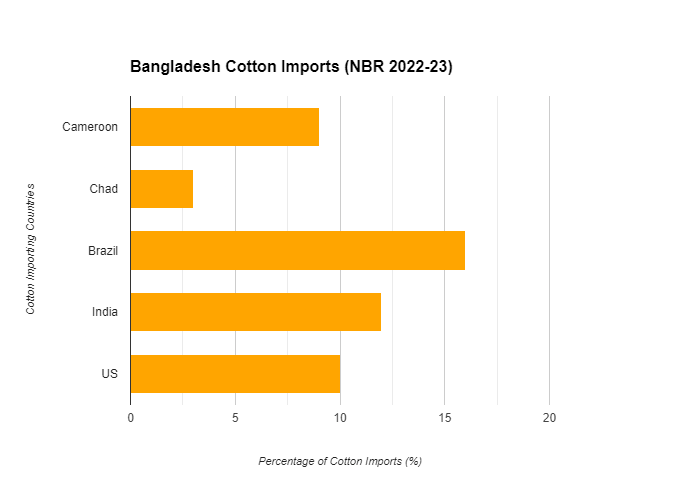Analyzing Bangladesh's shifting cotton import strategy.
Bangladesh, renowned as the world's second-largest garment exporter, is undergoing a transformative shift in its cotton import strategy. This shift, from primarily sourcing cotton from India to increasingly relying on African countries, carries significant implications for both regional and global cotton trade dynamics.
Import overview
Recent data from the USDA, based on Bangladesh NBR as of 2022-23, highlights the dominance of African countries in Bangladesh's cotton imports, with Western Africa leading the supply chain (Cameroon: 9 per cent, Chad: 3 per cent). Notable contributors also include Brazil (16 per cent), India (12 per cent), and the US (10per cent).
Historical data provided by the Bangladesh Textile Mills Association (BTMA) reveals a dramatic shift. In 2010, India supplied 22 per cent of Bangladesh's cotton needs, a figure that increased to 55per cent in 2015 before falling to just 12per cent. Meanwhile, African cotton imports have steadily risen over the past decade, buoyed by competitive pricing and efficient delivery facilitated by warehouses in Port Klang, Malaysia.
Factors driving the shift
Quality Advantage: Bangladeshi manufacturers assert that African cotton offers superior quality, leading to enhanced yarn and garment production. The African Cotton Association, supported by the Islamic Development Bank (IDB), provides financial assistance to members, enabling competitive pricing and swift delivery to Bangladesh.
Supply reliability: India's history of export bans to address domestic demand fluctuations disrupts Bangladesh's supply chain. Conversely, African countries offer consistent supply through IDB-backed warehouses, ensuring uninterrupted access to cotton. One of the main reasons for the increase in cotton exports is African Cotton Association. Members of the organization get special financial assistance from IDB enabling them to export good quality cotton at competitive prices and in a short period of time. And, Bangladeshi mill owners are able to take this advantage," said BTMA president Mohammad Ali Khokon Mohammad Ali Khokon
Competitive pricing: African cotton's price competitiveness further entices Bangladeshi importers, especially when coupled with its quality advantage over Indian cotton. The Islamic Development Bank (IDB) provides financial assistance to African cotton associations, allowing them to offer competitive prices to Bangladeshi importers
Quality and reliability concerns: Indian cotton suppliers face criticism for failing to meet quality standards and delivery commitments, prompting Bangladeshi mills to turn to alternative sources.
Implications for cotton trade
For India this means declining market share in Bangladesh signifies a loss for Indian cotton exporters, necessitating a focus on improving quality and reliability to regain competitiveness.
African cotton producers stand to benefit from increased demand and potentially higher prices, with further investments in infrastructure and quality control bolstering their position. Meanwhile, access to higher-quality cotton enhances the country's textile exports, reducing reliance on a single source and mitigating risks associated with supply disruptions.
While Bangladesh's import volume represents a small portion of the global cotton trade, the rise of African producers could introduce subtle demand patterns. Increased competition between African and traditional exporters might stabilize or lower cotton prices.
The evolving dynamics of Bangladesh's cotton import strategy underscore the intricate interplay between regional sourcing decisions and global trade dynamics. India's adaptation to quality concerns and Africa's burgeoning prominence present opportunities and challenges for stakeholders across the cotton supply chain. As Bangladesh continues to diversify its sourcing, the future of the global cotton trade hinges on adaptability and competitiveness among key players.

